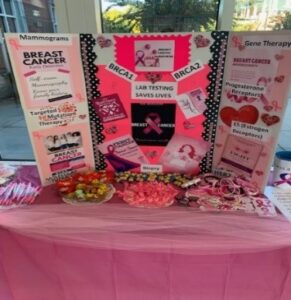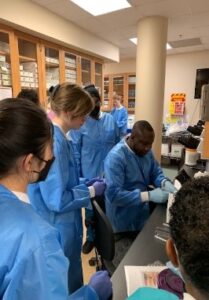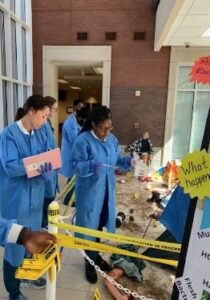Volume 38 Number 3 | June 2024
Phyllis Ingham, EdD, MLS(ASCP)CM, AHI(AMT), ASCLS Clinical Laboratory Educators Forum Vice Chair

One of the advantages of incorporating IPE into health science curriculum is its ability to foster collaboration among future healthcare professionals. Traditionally, healthcare education has been siloed, with students from different disciplines rarely interacting until they enter the workforce. However, in today’s healthcare environment, collaboration across disciplines is essential in providing quality patient care. By bringing together students from various health science backgrounds, IPE creates a platform for interdisciplinary learning and enables students to appreciate each other’s roles and perspectives. This collaborative approach not only enhances students’ understanding of healthcare, but also promotes teamwork and communication skills, which are vital for effective healthcare delivery.
Interprofessional Education Development
The first step in IPE development is to have a clear understanding of the learning goals for the activity being planned. The five basic IPE competency frameworks include:
- Roles and Responsibilities
- Ethical Practice
- Conflict Resolution
- Communication
- Collaboration and Teamwork
As you begin to organize the activity, it is important to incorporate one or more of these basic competency outcomes into the design of the team project. When incorporating interprofessional opportunities into the curriculum design, it is also important to note there are opportunities for both formal and informal learning experiences for the participating students. When students participate in formal IPE or planned learning experiences, the IPE works toward the goal of development of attitudes, knowledge, skills, and professional behaviors for all students participating.
Steps for IPE Design
- Bring the group together for initial planning. Bring all the stakeholders together, including student representatives from each group participating in the IPE activity.
- Adopt a definition, principles, and values (decide what your focus will be). What will the IPE promote? The five most commonly utilized core values and principles in IPE are: (1) focusing on individual, family, or community needs; (2) improving care, healthcare outcomes, and wellbeing; (3) respecting individuality, difference, and diversity among professions; (4) sustaining the identity and expertise of each profession; and (5) promoting equality among professions in the learning environment.
- Develop learning outcomes for the IPE activity. Agree on learning outcomes from the activity while also making sure the outcomes are achievable and accessible. Build the IPE activity to match the intended outcomes and competencies desired.
- Organize participants. Select the student groups (disciplines) and faculty facilitators.
- Brainstorm themes. Decide themes based on alignment with professional outcomes that focus on decision-making, care planning, communication, and teamwork, keeping in mind the theme must be appropriate for the professions involved in the IPE activity.
- Be collaborative in the activity design and use various learning methods. This must occur well in advance of the activity itself and is often the greatest challenge in the IPE development process. You can select to use case-based learning, problem-based learning, collaborative inquiry, observation-based learning, experiential learning, reflective learning, or simulated learning. The most important aspect of this step is to ensure the activity is interactive, reflective, and with a patient-centered focus.
- Determine level of learning. Direct the learning to fit with students’ capacity and stage of learning. You want students to be engaged and to develop a sense of their own professional identity, along with gaining an understanding of how to become a collaborator in the process.
- Facilitate the learning. As a facilitator, you will assist students to enhance their appreciation, understanding, and collaboration.
- Create a positive experience. You must create “student buy in” for positive engagement and success.
- Assess and use feedback from all who participated in the IPE activity. Assessment and feedback are paramount to make sure the IPE learning outcomes were met.
- Debrief after the activity ends. What worked well? What did not work well? What changes are needed to reach learning outcomes for the next IPE activity?
- Have fun and share your experience with others. IPEs should be a fun learning experience for all participants.
Using IPE in the curriculum assists in preparing students for the realities of the healthcare environment, where interdisciplinary collaboration is not just beneficial but necessary. By engaging in IPE, students learn to navigate the various avenues of teamwork and develop skills needed to thrive in a collaborative healthcare environment, so patient care outcomes become the focus of delivery of care. As we look to the future of healthcare, it is even clearer today that interprofessional collaboration will be essential, making IPE an indispensable component of health science education.
IPE Examples
Breast Cancer Awareness—Laboratory students and radiology tech students can work together to develop an activity for Breast Cancer Awareness Day. The groups can organize, plan, create posters and flyers, and develop college-wide activities bringing attention to Breast Cancer Awareness. Radiology tech students focus on the importance of early detection and mammography, while the laboratory students could focus on genetic testing and/or cancer antigens. Together the students share with others their role and work collaboratively in this team activity.
Crime Scene Scenario—Students from medical laboratory science might elect to work alongside criminal justice majors, and the IPE activity would be to solve a crime scene scenario. The laboratory students would learn processes and procedures for crime scene investigation and be able to perform blood typing from all the various samples found at the crime scene. The criminal justice majors would utilize their expertise for blood splatter, finger printing, etc. This scenario works great, and there are so many different variables that may be included that make it a fun and exciting learning opportunity for students to work together to try to put the pieces of the puzzle together to solve the crime.
References
- Belanger E., Rodriguez C. (2014) Immersive clinical simulation in undergraduate healthcare interprofessional education. Knowledge and perceptions. Clin Simul Nurs 10: e205-e216.
- Christie van Diggele et al. (2020) Interprofessional education: tips for design and implementation. BMC Medical Education Open Access Resources. https://doi.org/10.1186/s12909-020-02286-z.
- Lajaunie, Marissa, et. Al (2022) Learning Together to Work Together: Considerations for Interprofessional Education. Retrieved from https://journal.ahima.org/page/learning-together-to-work-together-c
- Salazar Jose H. (2017) Interprofessional Education themes in a Clinical laboratory Science Curriculum. Vol 30, No 2 Clinical Laboratory Science.
- World Health Organization: Framework for action on interprofessional education and collaborative practice. Geneva World Health Organization. Retrieved from https://apps.who.int/iris/handle/10665/70185. March 15, 2024.
Phyllis Ingham is Program Director, Medical Laboratory Technology & Phlebotomy, at West Georgia Technical College in Waco, Georgia.

Interprofessional education example: Breast Cancer Awareness

Interprofessional education example: Crime Scene Scenario


